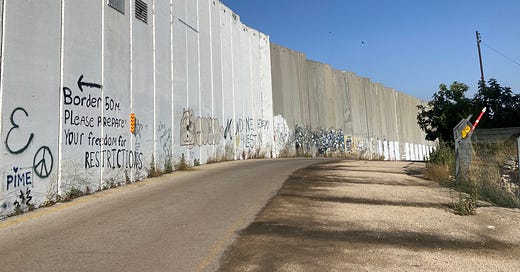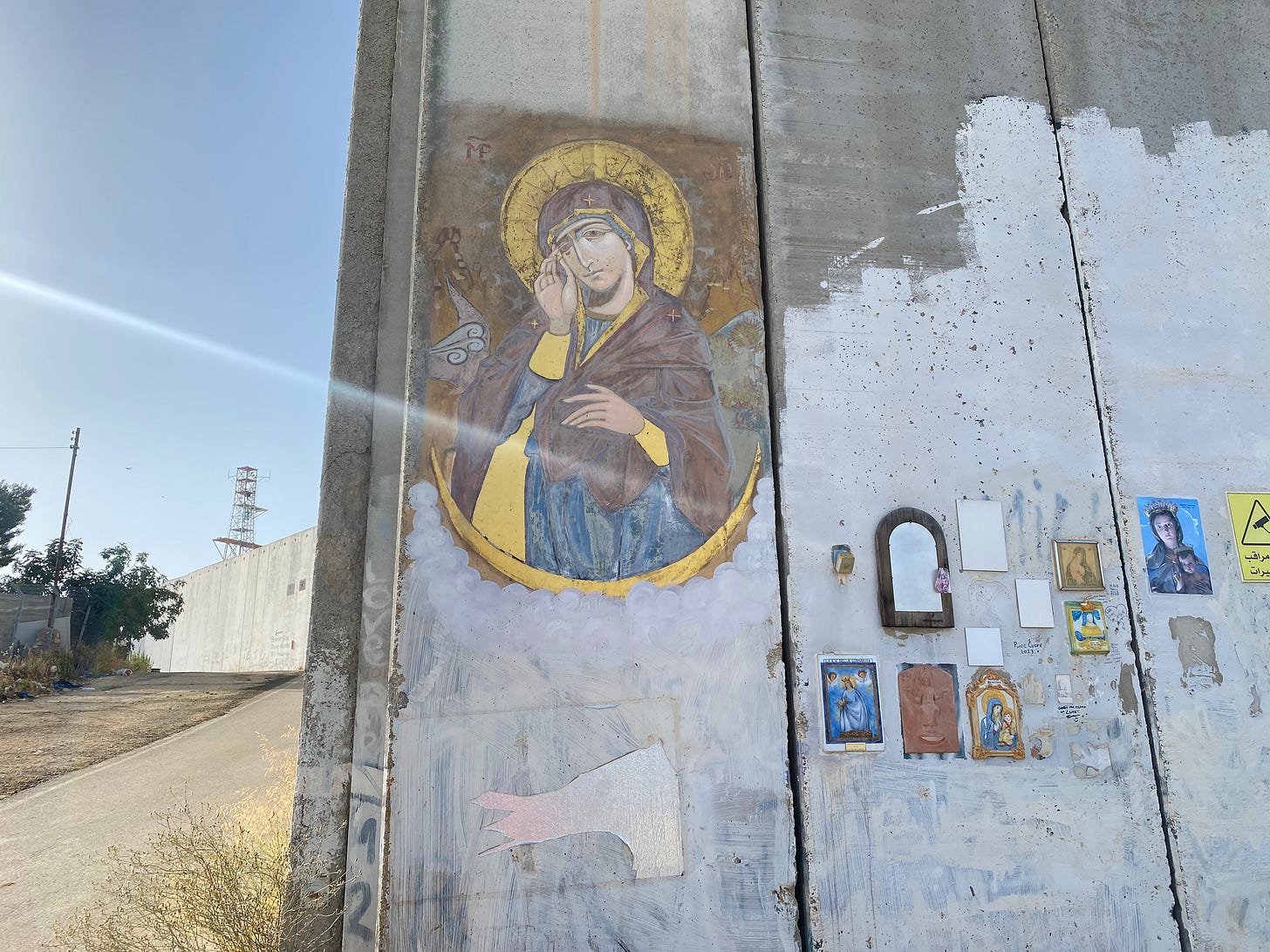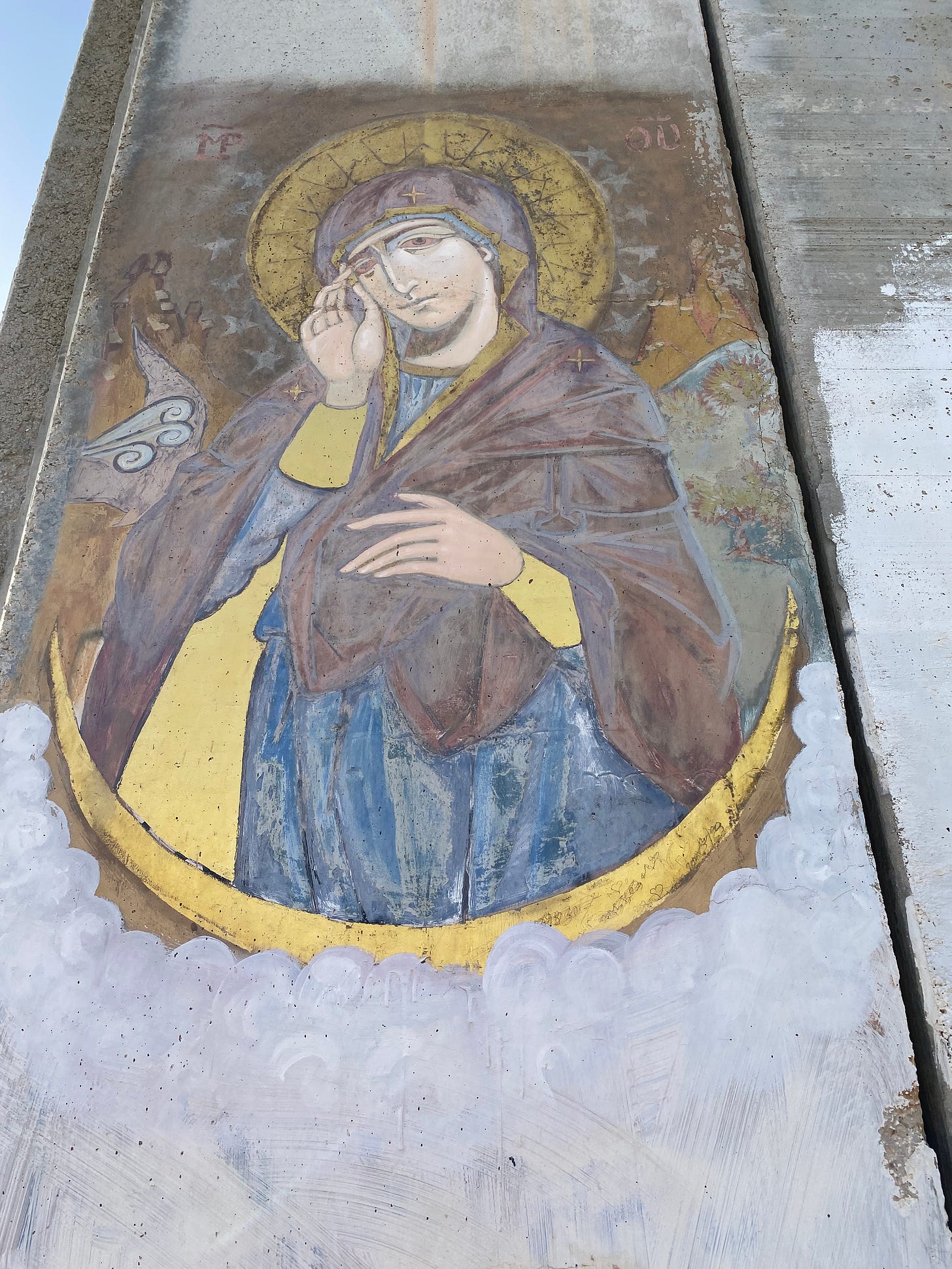I am sitting on my balcony, looking across old terraced olive groves in the valley below the ridge of Tantur. From the beginning of time up until 20 years ago, you could walk down Tantur’s flank, through the little valley and into the nestled hills that make up Bethlehm, unimpeded.
Beginning in June 2002, the separation wall—a 26-foot high concrete barrier, twice as high as the Berlin Wall—was built, cutting Bethlehem off from Jerusalem. Until the Bethlehem section’s completion in 2003, Latin Patriarch Michel Sabbah and the Custos of the Holy Land (the Franciscan Friar in charge of the Custodia, which oversees the Sacred places the Western Church owns) wrote letters that ran in U.S. Catholic papers, pleading for intervention.
Palestinian Christians are a minority in the Occupied Territories, and their numbers are shrinking. In 1922, at the end of the Ottoman Empire and the beginning of the British Mandate in Palestine, native Christians were 11% of the Palestinian population. Today, Palestinians living in the Occupied Territories make up 1% of the population. 80% of them live in Bethlehem, East Jerusalem, and in the surrounding villages and towns. The “living stones,” as Christians native to Palestine are often called, are disappearing.
Where do they go? Many of them have emigrated, to live a life in exile, but free from the daily oppression of occupation. The social fabric of Bethlehem is fraying, one father of four told me earlier this week. Communities cannot survive behind walls.
There are many protests: the second intifada was brutal, Israel sought greater security, the wall decreased the number of suicide bombings, etc. But there are many injustices in the wall: its height is punishing; the checkpoints are run—unlike any other border I have ever passed through—only by the Israeli army, it was built unilaterally by Israel, and it follows an arbitrary path that cuts through communities—85% of which is inside the 1949 armistice line that provides the borders we see between Israel and the West Bank on maps. But, as a recent UN map shows, the reality of occupation means that the Israeli military controls most of what looks like, on a basic atlas, territory under the control of the Palestinian Authority.
I am currently reading a book my grandmother lent me so many years ago, Hollow Land, by Israeli architect Eyal Weizman, on how the Israel military has used architecture to advance its political goal of total conquest of the land. In the chapter on the separation barrier, he writes:
By designating and constrainging habitats, by physically marking out the limit of different legal jurisdictions, these barriers [the fences, walls, ditches and barbed wire that make up the 700+ kilometers of the separation barrier] function mainly as administrative apparatuses of pupolatuion control, More than merely a fortification system, they became bureaucratic-logistical devices for the creation and maintenance of a demographic separation.
Like many segregated societies, Israel is not a monoculture ethnic state. It’s a multicultural society, but instead of creating a governing body that reflects that multiculturalism, the governing body reflects the goal of a homogenous ethno-state rather than the diverse reality of religion and culture that co-exists in both the state of Israel and the Occupied Territories (of the 120 Knesset members, only 10 are Arab). Homogeneity in governance is preserved by segregating the unwanted population. Similar examples closer to home should spring to mind.
Weizman says about the separation barrier:
[The wall] has also become particularly associated with the word ‘apartheid,’ although even at the height of its barbarity, the South African regime never erected such a barrier.
Tolstoy says that happy families are all unlike, and unhappy families are each unhappy in their own way. But I think it is the oppressed who are all alike, each of them bearing familiar scars, tragic in their predictability. Joy unites us in our singularities, but woundedness is the common factor in the human experience, and we inflict wounds on others, perhaps, to find some kind of warped communion in seeing our wounds present (and therefore bearable, finally) in the other.
Yesterday, a man showed me his tattoo of Christ on his arm, the perspective foreshortened so that we were looking at the savior from his lefthand side, the wound of the nail in his wrist aligning with the young man’s, and his hand becoming that of the Jesus on the cross.
Our Lady who brings down walls, pray for us, for the people of Palestine, for the Jewish, Christian, and Muslim neighbors living in your homeland, for the dismantling of barriers that divide us, and the walls of fear and hatred in our own hearts. Prayer Requests
One of my friends preempted this request by responding to my last post with a prayer request. If you have any prayer requests or intentions you would like me to pray for you during my next month in Jerusalem, please respond to this email, leave a comment, or leave me a note here. Our friend and saint of a neighbor John has requested salt from the Dead Sea, so if there are any sacramentals you’d like that won’t get me stopped at customs, please let me know as well.
Wee Announcements
If you facilitated a Synod listening session for your parish or have done a training or love leading small groups, we are looking for two (2) more facilitators for a listening session we are holding during the first cohort meeting of the Art and Synodality initiative through Catholic Artist Connection and Discerning Deacons. This initiative started with an email out of the blue, and it’s amazing to see the hard work, dedication, and grace that have gone into making it what it is. To me, the process of forming this project is an act of synodality—of walking together toward and with Christ, forming ourselves to be, like Mary disponible that is, open and receptive, to the Word of God in tradition, neighbor and community—in and of itself. I am excited to continue the journey this summer. We have close to 90 artists registered! Check out the webpage to learn more.
The panel on journalism and our report on paid leave in U.S. Catholic dioceses that Kelly, Sam and I spoke on last October can be watched here!
James and I spoke with our friend John (a different one than the salt-requester) about the Catholic Worker, Peter Maurin, cooperative economics and voluntary poverty on his podcast. James sounds great. I talk so much that it had to be split into two parts.









